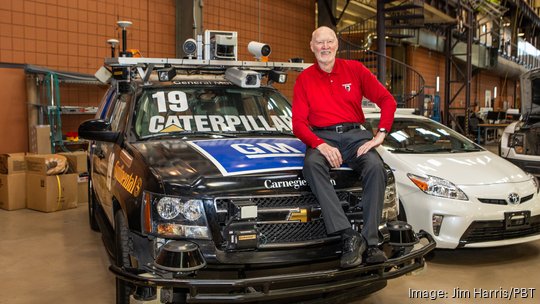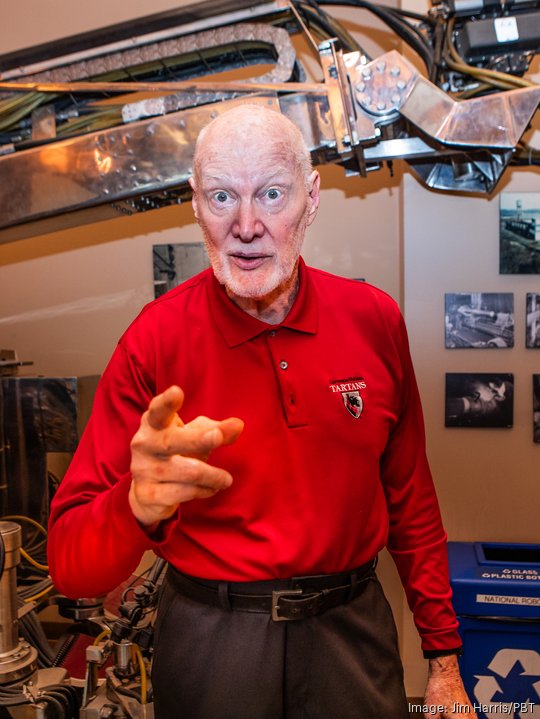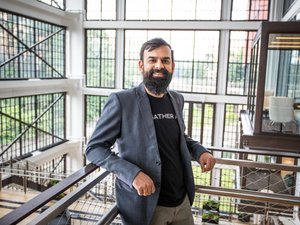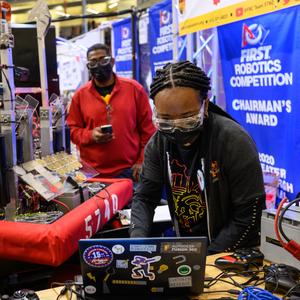In the ever-evolving landscape of robotics and automation, few figures shine as brightly as William “Red” L. Whittaker.
During a career at Carnegie Mellon University that has spanned decades, Whittaker has not only been a pioneer in the field, but also a driving force who has reshaped industries across nations, one robotic innovation at a time.
His local legacy is also one marked by profound accomplishment, with his efforts over the years helping establish Pittsburgh as a standout city for robotics-based developments that has the region capable of rivaling feats made by much larger peers like Boston or even Tokyo.
“When I got started, robotics was just fantasy and bad Hollywood movies,” Whittaker recalled. “I had this vision of thinking machines that work in the world. There was no evidence for that, no technology for that and no sense whatsoever of whether they would make it into industry.”
Fast-forward over the decades, and robotics is here to stay.
“It’s a growing game, it’s a going game, and Pittsburgh is an epicenter of that movement,” Whittaker said.
With unwavering determination and a relentless pursuit of excellence, Whittaker has consistently pushed the boundaries of what robots and humans can achieve together. But his impact goes far beyond the confines of academia and research labs; it engulfs major sectors of the business world, where his innovations have redefined standards of industry.
To celebrate these feats, Whittaker received a Career Achievement Award as part of Pittsburgh Inno’s second annual Fire Awards. The awards are part of an effort to recognize and celebrate the local startup community and the accomplishments of its founders and advocates. Throughout his career, Whittaker has served in both of those capacities and should his legacy be any indication of what’s to come from him in the future, his light on Pittsburgh’s budding tech scene won’t be dimming anytime soon.
A pioneer-turned-innovator
Whittaker, 75, grew up in Hollidaysburg, a small town outside Altoona.
After a stint with the U.S. Marines, he went on to obtain his bachelor’s in civil engineering from Princeton University in 1973, followed by a master’s and then a doctorate in the same field at Carnegie Mellon University in 1975 and 1979, respectively.
As he began his career at CMU, he quickly got to work on prototyping the use of robotics in ways that hadn’t been done before.
His first break into the robotics industry came shortly after the partial meltdown of a nuclear reactor on Three Mile Island near Harrisburg in 1979. By September 1983, Whittaker got the go-ahead from officials overseeing cleanup efforts to pursue the use of robotics to help solve some of the challenges the accident created, which posed too dangerous a threat at the time for humans to perform on their own due to radiation concerns.
It was a resounding success.
Within seven months, he had a series of working robots — the Remote Reconnaissance Vehicle, the Remote Core Sampler and the Remote Work Vehicle — capable of completing tasks like traversing through the contamination zone, collecting radiation samples and mapping, all while relaying images from the inside of the nuclear facility. It marked a significant transcendence for robotics at the time, since many were confined to fixed positions like those on automotive assembly lines.
“That put this brand of robotics on the map,” Whittaker said. “That put Carnegie Mellon on the map, and that put Pittsburgh on the map.”
It was also around this time that he developed the first “autonomous outdoor driving machine on the planet,” which he said served as one of the “important firsts” for a whole genre of robotics now known as field robotics.
“In many ways, that was the granddaddy of it all because I could then think within a year or two, well, this technology could evolve to the farm or mine or logistics or automotive and for exploration beyond planet Earth and so, so many things I didn’t see,” Whittaker said. “And the rest of the decades, I just built on that.”
The success of these robots led to the establishment of the Field Robotics Center at CMU, of which Whittaker still serves as director.
He, other fellow researchers and his students built robots capable of operating in hazardous settings deemed impassable for humans like volcanic craters, as well as those that could search for meteorites and even robots that mapped collapsed or abandoned mines.
Much of this work fell under the umbrella of RedZone Robotics, a venture Whittaker launched to sell or lease machines capable of operating in environments humans would rather not.
Whittaker said a core part of these early successes had nothing to do with robotics, but everything to do with the advancements seen during this time with computing. As computers rapidly evolved into smaller and more competent forms, they brought with them more advanced sensors that allowed robots to better see, hear, touch and even smell.
By 2004, the tech fueling much of the capabilities behind robotics had matured enough that the U.S. military expressed public interest in seeing if researchers could develop a machine capable of becoming an autonomous vehicle. The Defense Advanced Research Projects Agency from the Department of Defense launched the DARPA Grand Challenge to have teams from across the country test that theory as part of a series of competitions.
Whittaker led a team in the DARPA Grand Challenge every year it was held, and Sandstorm, the vehicle used for the challenge’s first year in 2004, traveled farther than any other participant with a distance of about 7.4 miles, though ultimately no team actually finished the inaugural competition.
Sandstorm and a new vehicle, H1ghlander, partook as entrants from Whittaker’s “Red Team” in the 2005 edition of the challenge and brought home a second-place and third-place victory, respectively.
Then in the 2007 edition of the challenge, which had an urban focus as opposed to the more rural terrain seen in prior iterations, Whittaker’s “Tartan Racing” team brought home a first-place finish and a $2 million cash prize after a 2007 Chevrolet Tahoe called “Boss” drove itself across the finish line.

“The world brought its best; those [teams] were in it to win it,” Whittaker recalled. “It was a game, and I buried them.”
Many of Whittaker’s students in these challenges would go on to start autonomous vehicle companies of their own like Aurora Innovation Inc. and Argo AI LLC, both based in the Strip District, though the latter shut down in October 2022 after running out of funding. But whether still operating or not, these robotics companies, which began as an idea pushed by Whittaker as a possible viable and commercial prospect, have gone on the change the world.
“If you look back, just take driverless cars as one high-profile example; yeah it started with that as an idea, but those people took the germ of those ideas and expanded upon it, created commercial entities, attracted the funding, raised capital and had thousands of jobs created as a result of that,” said Kevin Dowling, interim managing director at the Robotics Factory accelerator program from Innovation Works Inc. and a close peer of Whittaker for decades. “I think that’s far more impressive than any one machine.”
Another company Whittaker played a key role in getting off the ground was Astrobotic Technology Inc. Days after the end of the 2007 DARPA challenge, he pulled together a cohort of researchers and students at CMU to establish what would become Astrobotic as part of an effort to compete in the Google Lunar X Prize competition, which looked to award $20 million to the first team that landed a robot on the moon capable of moving 500 meters across the lunar surface while taking and sending images and other data points back to Earth.
And while no victor would ever claim the X Prize award before the competition’s termination in 2018, Astrobotic still stands today as a spinout led by CEO John Thornton, who was tapped by Whittaker. The company, based on the North Side with over 200 employees, is looking to celebrate the touch down of its first lunar lander on the surface of the moon before the end of this year.
“Astrobotic is a phenomenal example where Red was involved with John and later [John’s wife] Justine [Kasznica] with getting that up on top of who’d have thought Pittsburgh would become a central place for robotics and space,” Dowling said. “It’s really remarkable. And John is one of those people who benefited from Red.”
A legacy remembered near and far
Jennifer Apicella, executive director of the Pittsburgh Robotics Network, an advocacy group representing more than 120 robotics firms in Pittsburgh, said she’s often surprised, although she knows she shouldn’t be anymore, by how many individuals she meets who can tie a relationship or an interaction back to Whittaker as part of their journey in robotics, whether it be a project they worked on together, something they did at CMU or some other type of business connection or relationship.
“I think many of the people under his mentorship and under his tutelage would not have probably become entrepreneurs, would not have probably endeavored to start businesses and to make an impact in the world had he not given them the opportunity to understand that they should be thinking that way and that it’s absolutely possible,” Apicella said. “Really, [he’s] beyond a trailblazer in these spaces like mining, construction, agriculture, space.”
Apicella said she believes Whittaker’s leadership in this industry has inspired a whole wave of entrepreneurs and engineers to push the boundaries. In Pittsburgh alone, Apicella said there are over a dozen different industries and markets being served through innovations from robotics companies, many of which spun out of working under Whittaker.
“People cross his path and he ignites something in people, he sparks something and he creates a momentum in the spaces that he circulates,” Apicella said. “I see his legacy will continue to live on for decades more. And the groundwork that he has laid is so strong and it’s such a foundation of inspiration and innovation that it’s exciting to see that momentum grow and just continue to grow.”

To this day, Whittaker, who is also a Fredkin Research Professor of Robotics at CMU’s Robotics Institute, remains active on several projects. The Robotics Institute’s MoonRanger rover project is one of his more involved ventures currently, which could someday set out to search for ice on the lunar surface.
However, he contends that the time is nearing for him to perhaps spend more time on his 100-acre farm in Westmoreland County and less time at the National Robotics Engineering Center in Lawrenceville, yet another project he helped turn into reality over his career and one that serves as an anchor to the Robotics Row of companies that have popped up nearby it in recent years, almost all of which have ties back to Whittaker in one robotic fashion or another.
And above it all, he thanks CMU for allowing him to accomplish all that he has.
“You get the idea that Carnegie Mellon isn’t the only place in my career I can get a job,” Whittaker said. “But it has offered everything, and it continues to offer everything. In a nutshell, I can’t imagine another university anywhere where I could have gotten away with my career.”
Dowling, who has worked with Whittaker for close to 40 years, said he’s not expecting to see Whittaker fade away any time soon.
“He’s 75, but he’s still very active,” Dowling said. “You’re not going to find him on a golf course or fishing or hunting or any of the things that normal people would do to retire. His idea of retirement might be to work on some other project. So it’ll be so interesting to see what he does over the coming months and years.”
Join us at The Assembly in Bloomfield on Sept. 20 to honor our Fire Awards recipients and celebrate innovation, resilience and the spirit of entrepreneurship.
BIOBOX:
Title: Fredkin University Research Professor of Robotics and director of the Field Robotics Center, Carnegie Mellon University
Family: Kathleen Whittaker, wife
Education: B.S., civil engineering, Princeton University; M.S. and Ph.D., civil engineering, Carnegie Mellon University
Hobbies: Farming, mountaineering, classic car restoration
Prior board service: RedZone Robotics, Astrobotic Technology Inc.
CAREER TIMELINE:
1983 –1986: Pioneered robotic nuclear cleanup, self-driving and mine automation
1983 –1990: Founded field robotics discipline and RedZone Robotics
1994–1998: Founded National Robotics Engineering Center
2003 - 2007: Won DARPA driverless car race that ignited automotive automation industry
2009 - 2012: National Academy of Engineering, Ramos Medal, Columbia Medal & Feigenbaum Prize
2008 - 2020: Co-founded Astrobotic, igniting regional space enterprise
2019 - 2023: Developing robotic moon explorers and missions









